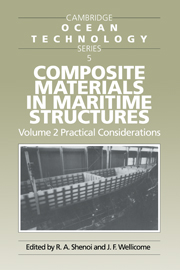Book contents
- Frontmatter
- Contents
- Preface
- List of Authors
- 1 Introduction
- 2 Design of Displacement Craft
- 3 Design of Dynamically Supported Craft
- 4 The Role of Adhesives
- 5 Practical Design of Joints and Attachments
- 6 Production of Ships with Single Skin Structures
- 7 Production of Yacht Hulls of Sandwich Configuration
- 8 Material Case Study - Failures and their Repairs
- 9 Response of Sandwich Structures to Slamming and Impact Loads
- 10 Fatigue Characteristics
- 11 Composites in Offshore Structures
- 12 Regulatory Aspects in Design
- 13 Quality and Safety Assessment
- 14 Design Management and Organisation
- Appendix
- Index
10 - Fatigue Characteristics
Published online by Cambridge University Press: 04 August 2010
- Frontmatter
- Contents
- Preface
- List of Authors
- 1 Introduction
- 2 Design of Displacement Craft
- 3 Design of Dynamically Supported Craft
- 4 The Role of Adhesives
- 5 Practical Design of Joints and Attachments
- 6 Production of Ships with Single Skin Structures
- 7 Production of Yacht Hulls of Sandwich Configuration
- 8 Material Case Study - Failures and their Repairs
- 9 Response of Sandwich Structures to Slamming and Impact Loads
- 10 Fatigue Characteristics
- 11 Composites in Offshore Structures
- 12 Regulatory Aspects in Design
- 13 Quality and Safety Assessment
- 14 Design Management and Organisation
- Appendix
- Index
Summary
INTRODUCTION
Fatigue may be described as a process which causes damage in material and structure under fluctuating loads of a magnitude much less than the static failure load. The accumulated damage may result in a gradual and significant decrease of mechanical properties such as strength and stiffness, in crack growth and finally into complete failure or collapse.
The speed of the fatigue process will be governed primarily by the magnitude of the fluctuations of the load or deformation cycles, commonly referred to as stress or strain range. Another load effect parameter is the height of the mean or peak level of the load cycle, although this parameter is of less importance as compared to the stress range.
The total number of load cycles which can be endured by the material or structure before fatigue failure is called fatigue life or endurance. Fatigue failure can be defined either as total collapse or as loss of adequate strength or stiffness. The maximum cyclic load or stress range a material or structure can withstand for a given fatigue life is called fatigue strength, while the maximum cyclic load that can be resisted indefinitely without failure is known as (lower) fatigue limit.
The relationship between the fatigue strength and the fatigue life is mostly presented in diagrams by means of S-N or Wohler curves for constant amplitude loading, see figure 10.1. The horizontal axis gives the number of cycles N on a log-scale, while in vertical direction the fatigue strength might be given on a log-scale or on a linear basis. The fatigue strength will be presented preferably in the form of stress range Δσ or double amplitude of the stress variation.
- Type
- Chapter
- Information
- Composite Materials in Maritime Structures , pp. 178 - 198Publisher: Cambridge University PressPrint publication year: 1993
- 1
- Cited by

